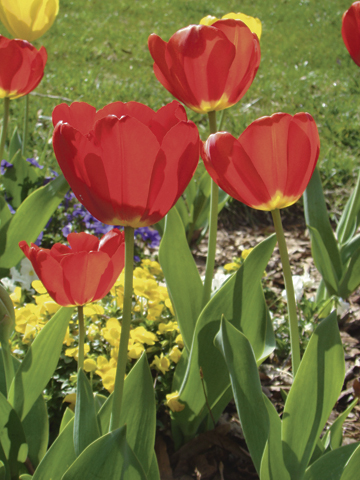Consumer Qs: cardinals, tulips, sweet potatoes
Published 7:00 pm Thursday, June 16, 2016

- Tulips may not perform as well in Georgia as they do farther north, but that doesn’t mean you shouldn’t try to grow them if you love them.
Q: A female cardinal keeps attacking the underside of the metal shelf of the gas grill on my deck. What is going on? It looks like she is attacking her reflection.
A: She is attacking her reflection which she sees as an intruder. Both male and female cardinals will do this as will other birds. (Robins are especially known for doing this.) Car mirrors and shiny bumpers are often the scene of these battles which most often occur in spring and early summer when aggressive hormones are high and the birds are obsessed with defending their territory against interlopers. We look at ourselves in the mirror and often begin to find fault; birds see their reflection and think “There is a dangerous intruder that must be chased away!”
To keep the bird from exhausting or hurting herself, cover the reflective part of the shelf for a few weeks.
Q: I love tulips, but don’t see as many here as I did up North. A friend told me they do not perform well in Georgia, and they may only bloom once. Is this true?
A: I may not have a voice like Andrea Bocelli, but that does not mean I can’t sing in the choir! If you love tulips, plant some this fall. While tulips are not the reliable perennials in the South that some other bulbs are, gardeners here can get several years of bloom from them if they improve soil drainage, select the right varieties and fertilize properly. If some of them do peter out after one year, didn’t they bring you a springtime of beauty and joy? And they were considerably cheaper than a Ferrari.
We promise to revisit this subject in the fall with a list of recommended varieties for Georgia and planting suggestions to increase your chances for success with tulips.
Q: I saw white sweet potatoes at the farmers market. I had never seen any before. What can you tell me about them?
A: There are hundreds of sweet potato varieties including some that have white, cream, yellow or purple flesh in addition to the familiar orange ones. Sweet potato varieties differ in sweetness, flavor, texture, nutrient content and storage life as well as in the color of their flesh and skin. You can’t always judge a sweet potato by its cover since some white-fleshed varieties may have purple or pink skin.
There are differences among white sweet potatoes just as there are among orange varieties. Some people describe white varieties they have tried as being less sweet than the orange ones while some people describe some white varieties as being sweeter. We have not found anyone who has tasted all the varieties so it may be best to refrain from making an umbrella statement regarding taste, a subjective matter to begin with.
Here is some information about a few white varieties that may provide some guidance. Sumor is less sweet than most white varieties and has even been substituted for Irish potatoes to make potato salad and other dishes. That makes it a possible alternative to them in areas too hot to grow Irish potatoes. Burpee describes Murasaki as having a “distinct nutty flavor” and Bonita as “the sweetest we’ve ever tasted.” Wayne E. Bailey Produce Co. describes Oriental as having a “sweet flavor reminiscent of a chestnut.” We recently tried O’Henry grown by Rise ‘N Shine Organic Farm in Calhoun, Georgia. It had a sweetness that lends itself to baking and being topped with butter like orange varieties but could also be used for making mashed potatoes or savory dishes.
If you have not tasted white sweet potatoes, give them a try. Don’t be shy about trying different sweet potato varieties in your garden as well as your kitchen. Garden centers will soon have sweet potato slips for planting. Or you can plant one of the sweet potatoes you purchased at the farmers market and grow your own slips for transplanting.
Trending
If you have questions about services or products regulated by the Georgia Department of Agriculture, write Arty Schronce (arty.schronce@agr.georgia.gov) or visit the department’s website at www.agr.georgia.gov






